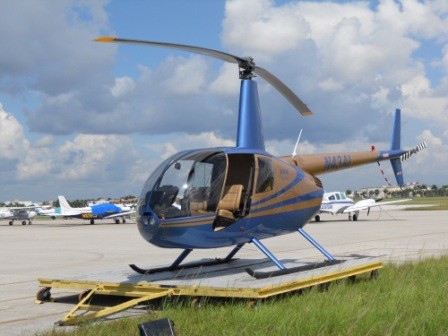Low-Altitude Aerial Images Allow Early Detection of Devastating Avocado Disease

UF/IFAS UF/IFAS scientists have used a helicopter to take pictures from about 200 feet above avocado groves in South Florida. The images provide early detection of the deadly laurel wilt pathogen.
Reza Ehsani, an associate professor in agricultural and biological engineering at the UF/IFAS Citrus Research and Education Center in Lake Alfred, used a multi-spectral camera that distinguishes between laurel wilt-affected trees and healthy ones.
Images taken with the camera from a helicopter have significant implications in the management of this important disease and for the commercial avocado industry in Florida. Ehsani said he expects the Federal Aviation Administration to open U.S. airspace for commercial use of unmanned aerial vehicles, which could be equipped with such cameras, by 2017.
“Ultimately, we think that small UAVs, equipped with the right multi-band camera, can be used for scouting for this disease, which could potentially be very cost-effective,” Ehsani said. “The results of this study will enable growers or service companies that use UAVs to detect this disease at an early stage.”
The ambrosia beetle, which transmits laurel wilt, was discovered in the U.S., in Georgia, in 2002. Laurel wilt was first discovered in the U.S. in 2003, also in Georgia. The devastating disease has spread rapidly along the southeastern seaboard of the U.S. and has begun to slightly affect commercial avocado production in Florida.
Laurel wilt is spread by ambrosia beetles and interconnected roots of avocado trees. The time from infection to tree mortality ranges from four to eight weeks. To prevent spread of the disease, it is important that trees be destroyed as soon as they are affected by the disease.
Since many symptoms of laurel wilt resemble those caused by other problems, such as, phytophthora root rot, verticillium wilt, fruit overbearing and environmental damage caused by freezes and lightening, a means with which laurel wilt could be quickly distinguished from other factors was needed.
Until now, aerial detection of laurel wilt was by visual inspection only, which is time-consuming and not always accurate. Follow-up of trees suspect for laurel involved locating the tree in the grove and collecting wood samples for lab analysis. Work conducted by Ehsani could dramatically reduce the time needed to diagnose this disease.
In October 2013, Ehsani and his team flew a helicopter almost 200 feet high over about 150 square miles of commercial avocado groves in southern Miami-Dade County. They used multi-spectral aerial imagery to find the trees affected by laurel wilt.
Ehsani worked on the study with Jonathan Crane and Randy Ploetz, professors at the UF/IFAS Tropical Research and Education Center in Homestead, as well as Ana de Castro, a post-doctoral research associate at the Citrus REC. The study was published April 30 in the online journal PLOS ONE.
About 4.4 million tons of avocados were harvested worldwide in 2012, according to a 2011 UF/IFAS-led study. The projected harvest for 2014 was 3.9 million tons, although specific figures are not known yet. California produces the most avocados of any state in the U.S., followed by Florida and Hawaii. Ninety-eight percent of Florida's commercial avocados are grown in Miami-Dade.
Other diseases can kill avocado trees, but none of them develops as quickly as laurel wilt. Left unchecked laurel wilt could drastically reduce Florida’s avocado production and economic impact, according to a 2010 study by UF/IFAS faculty members.
By: Brad Buck, 352-294-3303, bradbuck@ufl.edu
Source: Reza Eshani, 863-956-8770, ehsani@ufl.edu
Contact Information
Brad Buck
Science Writer
bradbuck@ufl.edu
Phone: 352-294-3303
Media Contact
All latest news from the category: Agricultural and Forestry Science
Newest articles

Durable, Efficient, Sustainable: The Rise of Cerium Oxide Thermal Switches
Groundbreaking cerium oxide-based thermal switches achieve remarkable performance, transforming heat flow control with sustainable and efficient technology. Cerium Oxide-Based Thermal Switches Revolutionize Heat Flow Control Thermal switches, which electrically control…

How Industrial Robots are Reducing Emissions in Global Manufacturing
A new study explores the intersection of industrial automation and environmental sustainability, focusing on the role of industrial robots in reducing the carbon intensity of manufacturing exports. The research demonstrates…

Patients Can Heal Through Precise, Personalized Bioceramic Grafts
A recent review is transforming the landscape of craniomaxillofacial bone regeneration with the introduction of personalized bioceramic grafts. This pioneering research explores the fabrication and clinical potential of synthetic grafts…



